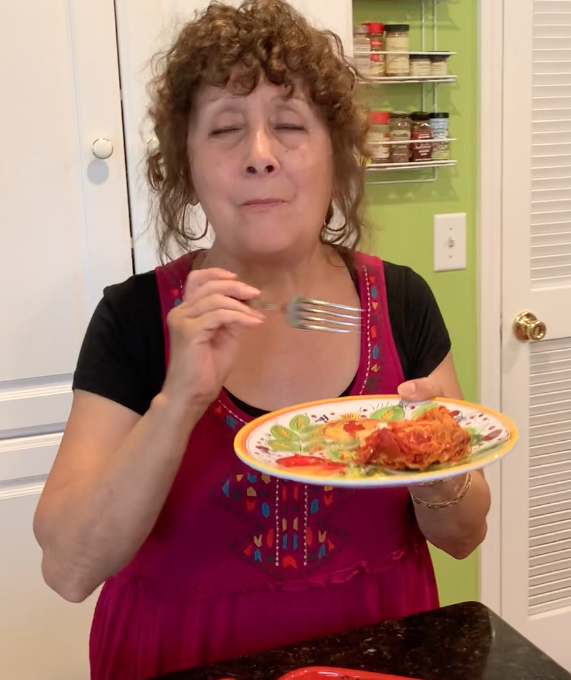
I’ve made a version of this dish for years. Then, in 2016, I took small group to Ragusa, Sicily (my ancestral home). We cooked with a family in their home and this is what they made. It was so good and proved once again that recipes in my family and the ones I encounter in Sicily and Campania have a very direct connection!
I used capellini. In Sicily they used a thicker fusilli. Either way- all good! I hope you’ll try it. Let me know how it goes. 🙂 Happy Cooking! Recipe below!




Spaghetti-Stuffed Eggplant
1 medium eggplant
1/2 cup AP or Self-Rising Flour
olive oil for sautéing
1 small onion
1 15-ounce can crushed tomatoes
splash of white wine
1/4 pound spaghetti or capellini
2 tablespoons butter
1 1/2 cup ricotta
1/4 pound mozzarella, cut into cubes or thin slices
salt & pepper to taste
Peel the eggplant in strips, so there’s still some skin. Slice thinly into large slices (so you can roll them up). Season the flour with salt and pepper. Heat a few tablespoons of olive oil in large frying pan. Dredge eggplant slices in flour and shake off excess. Fry eggplant until golden on each side and slices are softened. Drain on paper towels.
Heat a couple of tablespoons of oil in a medium saucepan. Add the diced onion and cook for 2-3 minutes until softened. Add splash of wine, let it cook out, then add tomatoes. Season with salt and pepper. Simmer for 8-10 minutes.
Heat a medium saucepan filled with water. When boiling, salt water, and add the pasta (break strands in half first for easier handling later). When pasta is done, drain, and stir in 2 tablespoons of butter to coat. Add 2-3 spoonfuls of tomato sauce to pasta and stir to coat.
Place ricotta in a small bowl and season well with salt & pepper. Stir to combine.
Preheat oven to 375 degrees.
Use a 9 X 13 inch pan or casserole or similar (something that can go in the oven). Add a little sauce to the bottom of pan to coat. Place a slice of cooked eggplant on a work surface. Slather some ricotta to cover. Place a couple of tablespoons of pasta. Top with a basil leaf. Roll to close (sometimes you can just close it without too much rolling)— place seam side down in pan. Repeat with the rest of the ingredients, and place the rolled bundles in snugly. Top with some sauce and sprinkle the mozzarella on top.
Bake for 30 minutes or until mozzarella melts and starts to brown. To serve, use a large spoon to get under each bundle to transfer to plates.































